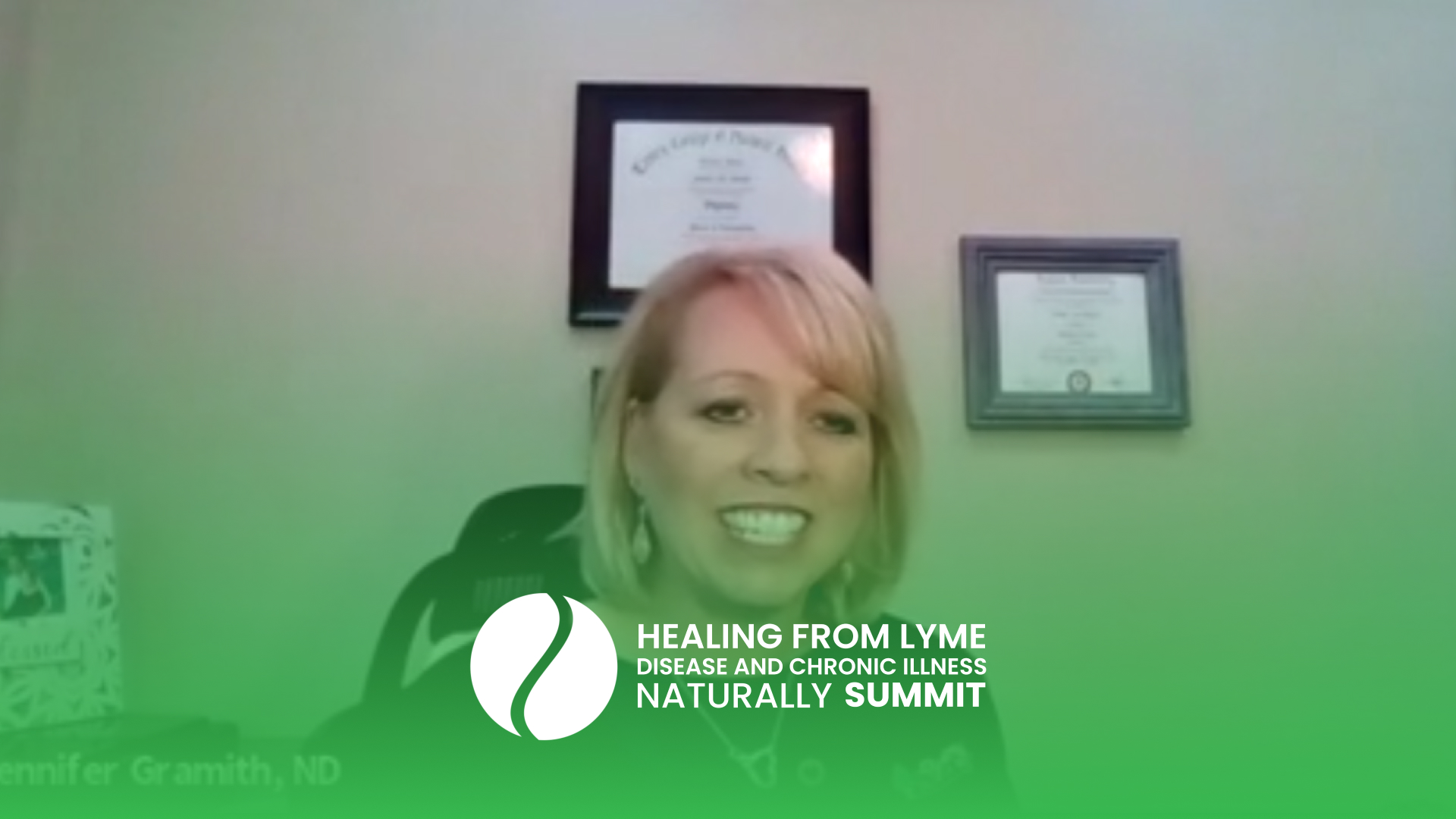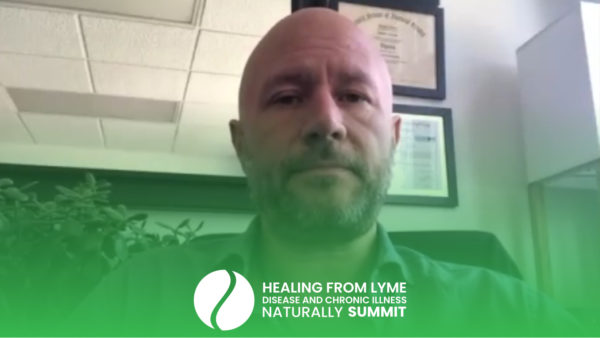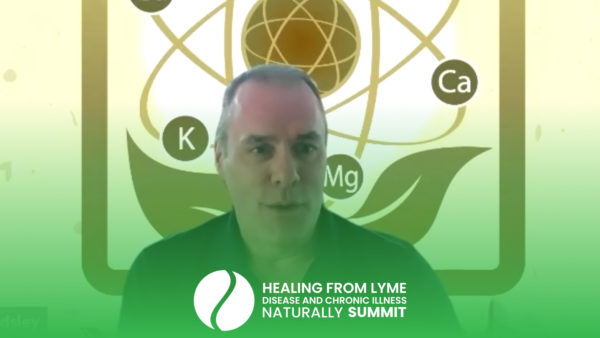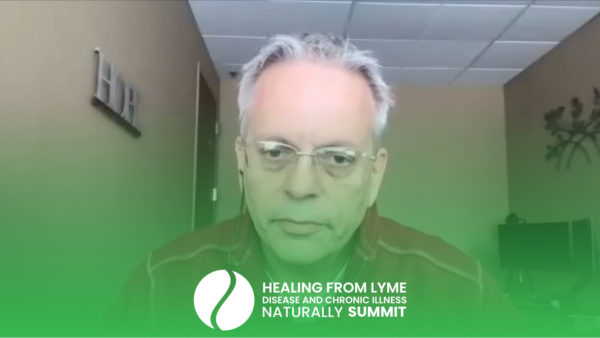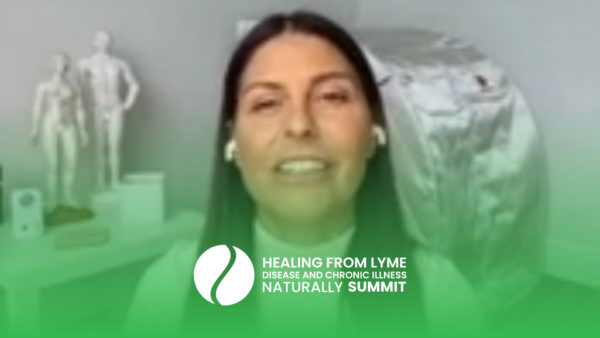Join the discussion below

Rob Besner, PSc.D, Co-Founder and Chief Science Officer of Therasage, has always been an advocate of natural health and wellness. Graduating from Boston University in Pre-Med, Engineering, Psychology and Business, he continued onto post graduate work at Case Western Medical School and Holistic Medicine After many years of illness, Mr.... Read More

Jennifer has a 17-year background in the medical field in internal medicine and holds a doctorate of naturopathic, accredited by the American Naturopathic Medical and Accreditation Board, Inc. Jennifer is also the founder and president of Rightway Health and Wellness LLC. She shares her many years of traditional medical training... Read More
- What is the connection between your Immune System and Lymphatic System?
- How do Lyme and other parasites affect your Immune system?
- Why isn’t your Immune system fighting off the Lyme bacteria?
- How can you assist your lymphatic system in fighting Lyme and the co-infections?
Related Topics
Chronic IllnessRobby Besner PSc.D.
Hey everybody, it’s Robby Besner and we’re back with another episode in our Lyme series. Therasage and Healthy Hotline is putting together, assembling the greatest team of all-stars with information to tell you about that you got to know. And today, I have to tell you, is someone that’s really dear to me, Dr. Jennifer Gramith. She is an all-star by every definition. In fact, if it was a baseball team, I’d have her batting fourth, that’s cleanup, because she will knock the ball out of the park every day of the week.
So Jennifer is a specialist. She’s built a company. Her company is called Rightway Health and Wellness. And you can reach her at rightwayhealthandwellness.com or if you wanted to actually reach out to her personally, if you just typed in her email, [email protected]. She’s a specialist in helping us create a healthy platform using your body’s physiology to actually build us a really strong platform to grow and really become optimally healthy. Her area is lymphatic drainage or the lymphatic system. And it’s so important. I mean, we really can’t thrive and be healthy without a healthy lymphatic system. So what does that mean? We’re gonna dive real deep. Let me introduce Dr. Jennifer Gramith, my really sweet sweetheart and a dear friend to the Healthy Hotline. Jennifer, how are you doing today?
Jennifer Gramith, N.D.
I am awesome, Robby. Thank you so much for inviting me. This is very dear to my heart. I have a lot of Lyme clients that I have worked with for over the last 25 years. And so it’s been quite a journey and a discovery. And you know, I think every year it looks a little bit different and we’re learning new things. And early on in my career, and I’ll go back and give you a little bit of my history, I was in mainstream medicine. I worked in nursing and cardiology, internal medicine and oncology. And my father developed lymphoma cancer as you know. And you know, he was a crop duster, had those chemicals sprayed on him directly.
He developed tumors that were the size of grapefruit in his abdomen, under his arms. And of course I worked in oncology. So what did we do? Chemotherapy and radiation. And unfortunately, you know, it made things worse and it destroyed his heart and they couldn’t. They gave him two months to live. And I was devastated. And so I know, you know, what it is, what it feels like just to have no hope because I knew how serious his condition was. And he was only in his early 50s.
I mean, he was young. Yeah. And I was a daddy’s girl. So you know, I became a nurse because I wanted to help people to overcome challenges. And I’ve always had that passion. And so I couldn’t help my father so that devastated me. But my medical director said, “Jennifer, “why don’t you try some alternative medicine?” That’s what it was referred to back then. And I said, “Well, you know, I’ll do whatever.” So we did. My father lived past the two-month point. Six months, the tumors were half their size. A year later, he was cancer-free. And that is why.
Robby Besner PSc.D.
Whoa.
Jennifer Gramith, N.D.
I know, and that is why I went on to school because you know, I’m watching my patients and I’m watching my father just thrive and thrive and the patients get weaker and weaker in most cases. And I couldn’t reconcile that. I really had to do something that I was passionate about. So I went back to school and that’s why I became a naturopath and that’s why my specialty has been revolved around the immune system. And so when I started as a naturopath working with clients and it was cancer and Lyme and, you know, heart disease, diabetes, I see all chronic issues even though my specialty is oncology. But when I started working with them, I kept running, you know, into the lymphatic system.
That was my problem system because I did well with changing their diet and giving nutraceuticals. And it worked well for a period of time and it seemed like they would just digress. And I was like, what am I missing? Well, that’s when I talked to Dr. Cowden and Dr. Croley who were mentors of mine and, you know, good friends of ours now. And they said, “Jennifer, are you addressing “the lymphatic system?” And I’m like, well, I don’t know. Am I? You know, I’m giving homeopathics and, you know, things like that. And they were the ones who introduced me first to the inert gas ionization machines.
And I started using that in my practice. And it was remarkable, the results. And it was the reason I got results was I was decongesting the lymph. And I didn’t even know really what I was doing in those early days, Robby. I knew I was dissolving inflammation and I, you know, by dissolving inflammation, I was able to stimulate their immune system. And I was able to direct their immune system where I needed it to be. So now all the nutraceuticals that we were using were working much, much faster. And so it was like, wow. So I saw that with the cancer group. I saw it with the Lyme group and the autism group. And it was just remarkable. So that’s how I got started. And like I said, I’ve been doing this 25 years.
Robby Besner PSc.D.
Wow, wow, wow, that’s decades. It’s amazing.
Jennifer Gramith, N.D.
Ridiculous. Yeah.
Robby Besner PSc.D.
You know, well, first off, you know, when you talk about a lot of things and you, you know, what people that just tuned in, we’re talking to Dr. Jennifer Gramith. And she’s a specialist in the lymphatic system. And people that, you know, it’s a word that gets thrown around like mitochondria health and so forth. So tell us a little bit for the people that aren’t, you know, dialed in so much to describe a little bit like the correlation or the connection between your immune system and then your own lymphatic system. How does that work?
Jennifer Gramith, N.D.
You would be surprised how many people don’t know. I didn’t know. And I went, you know, through nursing. And I had a chapter on the lymphatic system in nursing. And every other system we had a textbook on. And so you can think of it like this. Your lymphatic system is made up of your lymph nodes and collectors. It looks very similar to the circulatory system with all the, you know, veins and collectors. But it has these little filters. So what it is designed to do is to hold your immune system. Your immune system travels through your lymphatic system mostly, okay. So it’s the structure that holds your immune system. Most of us know about the lymphatic system as our detox system and that is what it is. It does detox us of or get rid of the debris and the toxins that we have exposures to. Whether it’s a pathogen or it’s a heavy metal or a chemical, it’s designed to identify it and destroy it and dump it. But what people don’t realize, it’s also the system that bathes every cell in the body with nutrients.
And so when you have a congested lymphatic system, you’re gonna be malnourished. And so how many times do you see that malnourishment with clients who are Lyme patients? You’re thinking that, you know, they’re taking all these supplements and they’re doing the diet but yet they still show very malnourished. And so the lymphatic system can really help, you know, distribute those nutrients like it should. So it not only directs your immune system to attack the pathogen. It also carries those nutrients to the cell. You know, one thing I used to think that, you know, and I’m looking at the lymphatic system and I’m looking at the immune system. You know, we’ve been kind of taught that Lyme will not, it’s true.
I mean, Lyme mimics a lot of auto-immune diseases, right? Okay, so you have to think. You really have to think about that. And I was trained that, you know, it’s your immune system’s just gone nuts and it’s just attacking your body for no reason. Well, that’s not true because your immune system is doing what it’s supposed to do. It’s trying to destroy pathogens. But think about Lyme. What is Lyme? It’s Borrelia, it’s a spirochete, and any other co-infections, and it spirals into tissue. So it could go into the brain. It can go inside cells and organs and glands. And so your immune system, a lot of times, the reason that it mimics an auto-immune response is because, you know, let’s say it’s in the thyroid. Your immune system’s like, oh, let’s get that out. So it will try to attack the Lyme that’s in the thyroid or the Lyme that’s in the brain. And so it’s actually doing its job. It’s just not taking in consideration that it’s, you know, it’s the host that it’s attacking.
Robby Besner PSc.D.
It’s attacking, right, right, Which is really the definition of auto-immune is the bodies can’t recognize the good from the bad so it just attacks everything, right?
Jennifer Gramith, N.D.
Well, it’s attacking the bad but it’s having to go through the good, yeah, for sure. And so you know, I remember early on people would say, you know, with cancer and especially with cancer is, oh, you don’t wanna stimulate the lymphatic system because it will cause the cancer to spread. Well, the very lymphatic system is what keeps your cancer cells and your pathogens knocked down to where you don’t develop disease. So it doesn’t really make a whole lot of sense to suppress the very system that saves you, right, I mean?
Robby Besner PSc.D.
Yeah, I hear that time and time again because oftentimes when certain cancers metastasize to the lymph nodes and then the lymphs nodes people think that the lymph node and the lymph system is carrying that cancer throughout the rest of the body systemically when it’s just like urban myth or something. I don’t know where that came from other than it’s just another scare tactic I think or something. I don’t know.
Jennifer Gramith, N.D.
That’s how I was trained.
Robby Besner PSc.D.
Yeah, there is a paradox though that I’d like for you to help me understand and people out there. All right, so the lymphatic system is driven by movement. Basically the lymph nodes reside in various different parts of the, I don’t know, you probably know the number that’s generally in the body. So I’d love for you to relate that to everybody out there. But they reside in your muscles and among the, yeah, mostly I guess in your muscles, right? And so then you, when you move your muscle, the muscle kinda squeezes or compresses. The lymph node that then passes the lymph along.
And so movement is a really important vehicle, muscle movement, vehicle to really move your lymphatic system. Lymph is a more viscous fluid, I suppose. And so stagnation, when you are, you know, in bed, you know, let’s say Herxing and you can’t move, the very thing you want to do is move because the movement actually creates a healthier lymphatic system but you just feel so bad you can’t move. So somehow we have to figure out how to get some simple movement or simple actions just to, even if you’re laid up, to at least keep that system pumping because that’s the thing that actually that’s one of the lifelines that brings you back to good health. So shed some light on that, unpack it for us because it’s a paradox to me and I, you know, we’re out there trying to get the tips from the master and that’s you. So let us know what we could about that.
Jennifer Gramith, N.D.
You described it very, very well. And, you know, that’s one reason I had the XP2, the lymphatic drainage device, developed was for those particular clients laying in bed, Herxing. And because when you do assist a lymphatic therapy, it prevents the Herxheimer reaction in many cases. And so you’re exactly right. The lymphatic system is a system unlike, you describe the difference between the cardiovascular and the lymphatic system without even knowing it ’cause the cardiovascular system is a closed system and it has the heart to pump the fluid. Well, the lymphatic system doesn’t. It actually piggybacks on top of the cardiovascular system and it doesn’t have an automatic pump. And that’s why when you live a sedentary lifestyle, it becomes even more congested. And so we want the fluid to be like water, the consistency of water, because these vessels, these lymphatic vessels that that fluid has to go through are like just a few stray strands of hair, you know, so very tiny.
That’s why it was overlooked for so many years. And so can you imagine trying to squeeze butter through those tiny little vessels? And that’s what happens when we live a sedentary lifestyle. That fluid is like a stagnant pond and it becomes thicker and thicker. So it can go from the consistency of water to butter to cottage cheese and then fibrotic. And so, yeah, yeah, it can be very, very serious. And so we want to make sure that and that’s why I had this developed. I wanted to be able to dissolve the congestion back into a watery state so it could easily flow through those collectors.
Now, the collectors, because the lymphatic system doesn’t have an automatic pump like the heart, the collectors have what is called an angion. It’s like a spiral muscle around the collector that, as the fluid goes into the collector, it will swell in the collector, then will squeeze it. But you have to have movement, just like you said. So your muscles is actually what gets that movement to push that fluid into the next little lymphangion, into the next one, into the next one, carrying it to the lymph node. And so you do have anywhere between 600 and 15 to 1,700 lymph nodes in the body. That’s, you know, if you look at one textbook, it’ll say six to 900. Another one, you know, ’cause it’s such an unknown system. And so we’re still learning a lot about the lymphatic system and how it works and, you know, how to manipulate it to help our clients to feel better faster. And so I have it’s a foundational therapy in my practice.
And it doesn’t matter if you have Lyme or cancer. It’s the foundational therapy because I have been testing for over 25 years and about 80% or more of the clients that I see have a, you know, pretty severe amount of congestion in their lymphatic system. You can ask any thermographer, you know, and they’ll say, “That’s the biggest thing “that I see, Jennifer, is I see “that there’s so much congestion in their lymphatic system. “And then I don’t know what to do to tell them “to help themselves other, you know, “than dry brushing or exercising.” And as you know, a lot of our clients are so sick. I mean, the Lyme community is such a complicated, you know, disorder because it’s like mimics so many auto-immune.
But it’s not impossible. And you know, we’ve had great, great success. I’ve worked with hundreds of neurological Lyme patients over the last few years. And those are some of the toughest cases because they don’t have the mental energy. They don’t have the physical energy. And what we see is when we stimulate their lymphatic system and help direct their immune system that they start getting energy. They feel better. Their protocol works better for them.
They don’t have the Herxheimer reaction from every, you know, new supplement that we give them because they’re super, you know, typically they’re super-sensitive. I see also, I see more environmental sensitivity clients with Lyme now so now they’re developing even more of a sensitivity to the outside environment, light, sound, smells. It’s a huge issue that I think, you know, that we need to definitely resolve and can be resolved. And we’ve had great success with our clients here at Rightway. And you know, I just I really want to your group to really feel like there’s so much hope, there’s so much out there for them, and we won’t stop until, you know, everyone is better. And so don’t give up.
Robby Besner PSc.D.
Well, yeah. I love that. Man, there’s so much to talk about. From my understanding, this is just a mechanical thing. So the lymph node kind of like, let’s say this is the node, it’s got a valve on one side. And then when the muscle or, like you said, the vehicle that actually squeezes the lymphatic tube, right, pushes the lymph into the node, then the muscle pumps and then the valve, it squeezes by the squeezing of the muscle, it squeezes and opens the valve, allowing the lymph to come through.
Then the valve shuts so that the next, it’s ready for the next station. And then you move and it goes to the next one and so forth. And so it’s this constant valve, open and shut. And why someone like yourself, like an expert in lymphatic drainage, knowing techniques, knowing the people probably have heard of lymphatic massage. And that’s really what you’re doing is you’re sort of taking the cottage cheese back to butter, back to a fluid, and then also easing up the pressure that might be formed in the clogging of this node so that it can actually operate mechanically.
Jennifer Gramith, N.D.
What you’re talking about right here. This is what a lymph node looks like in the . Not quite this large.
Robby Besner PSc.D.
Oh my goodness. It’s show and tell. Oh my goodness. That’s amazing.
Jennifer Gramith, N.D.
It’s show and tell. And so you’re exactly right. So you have collectors coming into the node. And here is where all your little T cells reside that is ready for that pathogen. When that spirochete comes in here, it’s ready to attack. And then it exits through another area of the lymph node. And this is the collector and the way the collector looks. And I don’t know if you can see that little valve that you are talking about, yeah. So there’s these little one-way valves that carry the fluid into the node and then let the white blood cells, the immune system, do its job and then it takes it out.
And you can also see that you have the blood supply to the lymph node. And so even though your lymph nodes are not quite in the muscle but they’re, you know, around the muscle. So your regional lymph nodes are like the axillary and the inguinal and your cervical lymph nodes in the neck. And so they are, when you exercise and you get your blood flow pumping, that’s what causes the lymph, it’s called lymphangio-motoricity, that causes the contraction of those angions in those collectors, pushing it through all of these nodes and so.
Robby Besner PSc.D.
Well, I love that but for everybody just tuning in, that’s not how big the lymph nodes are in your body. That’s a really.
Jennifer Gramith, N.D.
Unless you have non-Hodgkin’s lymphoma and then it could be that big.
Robby Besner PSc.D.
Wow, that was really terrific because you know, it really helped me visually understand this is where your whole immune system sits with those T cells that are sitting inside that node, just waiting. That’s your army that’s waiting to attack that pathogen, that invader. So it makes way sense that if that system isn’t really operating, you know. So what we’re learning today is very specific for the Lyme community. But anybody that’s watching today, anybody needs to understand how important a healthy immune system and a healthy lymphatic system is, to be conscious of that. Wow, this is big stuff. You know, you are not just a practitioner specialized in the lymphatic system, you are also someone that’s an integrated, functional doctor.
So you’re not just looking at this. Even though this is your consciousness, you draw upon Dr. Cowden like you mentioned, his academy, the people that you’ve met over the years in the various different networks. And you bring all those tools together at Rightway. What a great name. To learn the right way about health, go to rightwayhealthandwellness.com, meet Dr. Gramith and her team. And if you went on her website, which is by the way beautifully done, all you see are these happy, smiley faces of all the people that work for you, your colleagues, the people in your practice. And it’s really very refreshing. You’ve said this in a roundabout way but let’s sort of zero in to the Lyme patient listening today, why it is that and by the way, we talk about exercise and movement.
So it isn’t, you know, especially if like you’re flat on your back, it may be hard for you to conceptualize to do that. We’re not asking you to run a triathlon, go, you know, go ride a, you know, a 10-mile, do a 10-mile hike or ride a bike for a few miles. This could be as simple as just getting out of bed and doing some stretching and doing some squats or one of my favorites are the vibration plate. And you can buy those for like 100 bucks on Amazon, right, have it delivered in a day. Dr. Cowden was great on that one. He had me in his office when he was in Texas and he had me on my back on this plate and he goes okay, now we’re doing lymphatic drainage. Just lift your legs up. And I’m just sitting there relaxing, going .
You know, everything was shaking. But that vibration can be oftentimes all you need to move the stagnation. So just for people tuning in, we’re not looking for strenuous bodybuilding-type stuff to move this around. We’re really just talking about movement. And that’s a big distinction I think that people need to know because oftentimes they kinda get a wrong idea about what they need to do and it just becomes too outrageous. I can’t do it. I don’t feel good. But these are things that are easy and not expensive. So man, we covered so much. I’m just thinking about what we may have left out. We have a few minutes left and I guess, you know what, let’s talk a little bit about you developed a device, you know, and I think that that’s important for people to know. So and also you’re not just someone that’s a expert in this area. You’re about teaching and learning. So you’re always on that learning curve. I mean, every time I meet you and I talk to you, you got something else, and it’s really exciting to talk about, about what you’re doing.
And you don’t just do that through your practice but you have a network of practitioners that you also follow and that you teach and that you bring advancements to. And now I understand you’re gonna combine all this in sort of a university setting, which is super-exciting because, you know, in this virtual world, we all wanna gain more knowledge. So it gets you not just as a thought leader but it also puts you way ahead of everybody else out there in your area in the advancements in this lymphatic, knowing about the lymphatic system and simple ways to do it. So let’s talk a little bit about, you know, why you developed this device. And I think you touched on it a little earlier about what it does. But maybe we can dive in a little deeper on that one because it’s really interesting to me.
Jennifer Gramith, N.D.
Yeah, no, they’re, you know, it’s funny how my businesses just organically shifted and changed. And it’s kinda like the way our life is. So I developed the XP2 to out of sheer need to help my clients move to the next level. And you know, most of us as practitioners run, you know, against those or we get those clients that, you know, they’re sensitive to everything that they take. They can’t take medications. They can’t take supplements. They’re always Herxing. And so that was really frustrating to me.
And I don’t, you know, 70 to 80% of your immune system lies in the gut. And so I’m a manually trained lymphedema specialist. So I know the massage technique as well. But I needed something to really be able to go deep into the belly, into that deeper lymphatics and stimulate that immune system. And that’s why I had the XP2 developed was to be able to do that with my clients. So, you know, and how many of us struggle? I mean, all of us struggle with leaky gut. It’s an epidemic, you know?
Robby Besner PSc.D.
Yes, that’s true, especially with glyphosate, the glyphosate challenge that is not helping us, yeah.
Jennifer Gramith, N.D.
It destroys that tight junction. And so now we have all these proteins that should not be outside the gastrointestinal tract going into the blood and the lymph and creating just this systemic inflammatory pattern. And so the one reason I had it developed that was made it just much more effective than just my manual technique, we use it same as we do manual technique. It’s a full-body approach however. But what it actually does is it chews up and dissolves that inflammation, kinda like our probiotics and, you know, our enzymes and the things. And so when you combine that with using those products, it’s remarkable the results that you get.
Robby Besner PSc.D.
You get that synergy. You get the synergy effect of the yeah.
Jennifer Gramith, N.D.
So it took me from about a 35% success rate with stage-four cancer patients to a 75 and 85%. Lyme patients, same thing. It was just amazing the difference. And in, like I said, early on, I didn’t really understand why it was working so well. I just went with it. And so over the years, now I’m a lifetime student. Okay, so I’m may be a doctor, may be a teacher but I am a lifetime student. I take classes all the time because we will never know it all and I think that we just have to keep searching for knowledge and we have to take that knowledge and we have to share it.
That’s, you know, that’s what God would have us to do. I really feel like that’s, you know, so I do appreciate you doing this because it’s just such a beautiful thing to just give that gift of knowledge to people, give them hope. And so but yeah, you know, with the XP2 and the lymphatic therapy, it’s been remarkable at just decongesting. So manually you massage and you manually force the fluid to go through the channels. With the XP2, the difference is that it actually causes a disassociation of those proteins, you know, those nasty proteins causing that inflammation in the heart and elsewhere in the body.
And it causes that disassociation of that protein. And then it just flushes it out. So it works much quicker. And so when it would take me, you know, hours to do, it takes me one hour once a week, you know, it’s what the standard protocol is for these types of cases. And they leave feeling better and more positive. Get rid of the brain fog, you. You know, give them energy. Get rid of the pain too because it helps to pull that inflammation out of the joints and the connective tissue and it cuts down the Lyme rash. You know, a lot of your clients and patients will, you know, suffer from that. So yeah, it’s remarkable.
Robby Besner PSc.D.
Well, I’m ready to sign up right now. You got me. Actually, you had me at hello, Jennifer, honestly. So I know you have a network. You’ve been doing this for 25 years. For people out there, like what do they do? Do they just call up a practitioner and they say, “Do you have the XP2? “I just heard so much about it from Dr. Gramith.” Like, how do we find you? Like, we know how to find you. But also you’ve got a, you know, an army of practitioners that you’ve been working with over the years that are spread out all over the country.
Jennifer Gramith, N.D.
All over the world. Yeah, we actually have it in 17 cancer clinics in Asia. And we have it, you know, all over. So you can go to our website here for the US. And you can actually type in or look up your state and it’ll tell you locations and contact information of a therapist near you. And so but we also have, you know, with a lot of Lyme clients, we have home models that they can use and learn how to use on themselves. And so, you know, it’s something that they’re typically gonna do for quite some time. So it may be more economical for them to learn how to do it on their, you know, their own lymphatic system.
Robby Besner PSc.D.
Well, that’s great news to know that I can get this device and I can actually do some self-care ’cause many of the people out there, they’ve got support groups and their family and everyone’s frustrated because they spend hundreds, you know, of dollars, thousands of dollars on medication and working with practitioners. And some of it works. Some of it works for a little time. But you know, I always love when the patient participates, like when they actually own it and they take care of for themselves, you know. And even in our coaching and from our perspective, my view would be to teach my clients or my customers everything they need to know so they could be their own best doctors.
I don’t want them to be codependent on me. And I love the fact that you have a system that you can export out, you know. And then I guess they check in with you or with your clinic and with your advisory team and they learn how to use it. And then they can treat themselves and treat their family members because this isn’t just for the people with chronic challenges. We’re talking about chronic Lyme but there’s so many other chronics out there. The lymphatic is definitely one of the core systems that you have to have onboard in order for everything to work right. There’s no doubt about it.
And so, you know, the things we’ve talked about today are so key to good health in general, not just for the Lyme community. So thank you so much for your contribution and everything you’re doing. It’s unwavering. From the minute I met you, it’s just that’s you’re just like, ah, you know, a ball of energy, couldn’t be more excited or engaged in the things that you’re doing. And it shows you’re really making a difference and moving the needle. So we only have a few minutes left and I don’t know if we covered everything on your mind. On my mind, I think that, you know, is there simple massages or just simple things I could do? Like, sometimes you can feel a lymph node when it’s a little bit engorged or enlarged or stuck. So what could I do to just sort of move it along to just, I don’t know, I guess on the most primal level, just to get something jumpstarted?
Jennifer Gramith, N.D.
No, I think that’s ideally and you know, you need to learn how to do lymphatic therapy at home. And so basically that’s just like manual massage. And so if you are swelling or having pain, you’re going to just work it up to your regional lymph nodes, which are the axillary. So everything from the hand’s gonna go up towards the axillary. On the lateral portion will go up towards the thoracic right lymphatic duct. And so there are videos that you can watch online that will tell you exactly how to massage it.
And also dry brushing. But something that’s really simple is get a Pilates ball and balance on the Pilates ball. You just like the vibration moves the superficial and the deep lymphatic. And so just do that 10 minutes twice a day. And if you can’t even do 10 minutes, just work up to that. And so but those of you who are laying in the bed and you don’t even feel like you can do that, deep breathing actually stimulates your lymphatic system. So practice that until you have enough energy that you can get up and you can do the Pilates ball.
And then, you know, just graduate a little bit more and a little bit more ’cause it’s not about doing it at all today. It’s about getting better, a little bit better, every day. And so there are some ways just like the assisted lymphatic therapy that will help you get there much quicker but that not everybody has access to that. And so these are just little simple things that you can do.
Ginger tea is a great lymph drainer. There’s homeopathics that drain your lymph. I wanna tell you this, that a lot of times when people have swollen lymph nodes, they panic and they’re like oh my gosh, is it cancer, is it cancer, you know? And if you palpate your lymph nodes and your lymph node, when you palpate it, feels like little BBs inside it, that’s usually just a viral infection, okay. So when it feels like BBs, it’s virus. When it feels like just a squishy little lump, that’s usually a bacterial infection. Unless it and when it’s sore, it’s really nothing to worry about, okay, so don’t panic. But now if you have a node swell up and it’s hard and it’s not tender and it’s just not going away, then that would be one that you would, you know, have checked out.
But it also can just be calcification too. You know, so the trauma of some of these diagnoses that people get or they start to think create more disease process in their body. So you know, don’t freak out when you have a lymph node swell up. Just palpate it and kinda see what it is. And it will go away if you take some immune-boosting supplements, you know, zinc, vitamin C. If it’s BBs, I’d take vitamin C because that knocks down the viral loads. You know, if it’s squishy, take an olive leaf or something like that, some natural antibiotic. Yeah, so simple things that you can do to really help your lymphatic system and your immune system that’s within the lymphatic system function. You know, give it the food it needs. Give it the movement that it needs and it will serve you well.
Robby Besner PSc.D.
Wow. Great news. I use sometimes I use our infrared, like the infrared red light or the full spectrum stuff. And it also gives me, it lowers my pain if there’s a little sensitivity. It feels like it’s making the lymph a little bit like more viscous so it’s more liquidy. And it takes the pressure off. So I’ve found some results from there. But these are all amazing tips. Wow. As I thought you would, as you do every time I get together with you, you knocked the leather off the ball.
You’re amazing. Rightwayhealthandwellness.com. Jennifer Gramith. Thank you so much for joining us. You’re amazing. Appreciate your contribution. You guys out there, if you don’t look this woman up and get hooked up to what she’s doing, you’re really missing out. She’s really on top of her game and one of the experts in the world in this area. So thank you so much for joining us. And I really appreciate your contribution today.
Jennifer Gramith, N.D.
Thank you. It’s of my pleasure always.
Robby Besner PSc.D.
Hey everybody, it’s Robby Besner. Thanks so much for joining us today. Please share this content with anyone that you think might benefit from it. And we’re looking forward to having you with us tomorrow for another great interview.
Downloads

